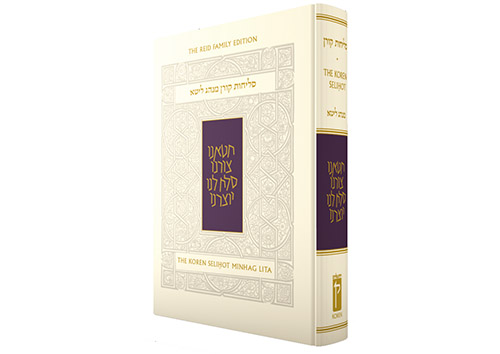
Highlighting: The Koren Selichot Minhag Lita introduction and commentary by Rabbi Dr. Jacob J. Schacter. Koren Publishers Jerusalem; Bilingual edition (August 1, 2022); Language: Hebrew, English; Hardcover: 1,314 pages; ISBN-10: 9657766680; ISBN-13: 978-9657766682.
Many hours during the months of Elul and Tishrei are dedicated to the recitation of Selichot, prayers for forgiveness and mercy. Ashkenazi Jews begin reciting Selichot prayers the Saturday night before Rosh Hashanah, or the Saturday night of the previous week if there are fewer than four days between the beginning of Selichot and the first night of Rosh Hashanah. Prayers are recited each night or early morning, except for Shabbat, through the night preceding Yom Kippur.
The Selichot prayers contain difficult language and prose, making the hours-long synagogue experience impersonal for many and creating a barrier to connect on a deeper level to the prayers. In order to make the prayers more accessible and meaningful for worshippers during these Days of Awe, three years ago Koren Publishers Jerusalem embarked on a project to publish a Selichot volume containing a modern translation and comprehensive commentary. The result is “The Koren Selichot Minhag Lita,” with introduction and commentary by Rabbi Dr. Jacob J. Schacter and translation by Sara Daniel.
For Rabbi Schacter, a Yeshiva University professor and renowned scholar who holds multiple prominent Jewish communal positions, this extensive project took on deep personal meaning. He devoted many hours of research and writing during the height of the COVID pandemic and lockdowns. During this time, he lost two family members to the disease. Yet he chose to seek out strength and optimism during this period, which is reflected in his commentary.
Though many of the passages of Selichot express the mortality of human beings and their evil nature, Rabbi Schacter tended to focus on the upbeat passages that underscore the strength that God provides his people. “I was writing this in the thick of COVID and I was surrounded by such depression and worry, and we were overwhelmed by the sadness,” Rabbi Schacter shared. “Here I was deeply immersed in those texts and I grasped onto those that helped me get through COVID.”
Rabbi Schacter worked alongside Sara Daniel—“a remarkable linguist and scholar”—whom he praised for her outstanding translation of the text. Koren Managing Editor Caryn Meltz managed all the technical aspects and the publication of the work.
The volume opens with a 70-page introduction and continues with an extensive commentary to accompany the Selichot passages. No other English version of Selichot contains such a detailed introduction and comprehensive commentary. Rabbi Schacter drew his commentary from a variety of sources that comment on the Selichot prayers and rabbinic texts, as well as his own thoughts and those of his late father and wife. His commentary is thematic rather than literal, poring over themes such as the 13 attributes of faith and the motif of the akeida, among many others.
His commentary often relies on the historical context and environment in which the passages were written. “Many of the Selichot were written by 12th century Ashkenazi scholars who witnessed the Crusades,” Schacter explained. Jews were surrounded by slaughter, and their tenuous situation as victims played a big part in the development of the texts. As an example, the akeida story became very personal during the Crusader period, and this theme appears prominently throughout the Selichot. But different from the biblical narrative, the Selichot passages relating to the akeida portray Isaac in a more active role, a narrative that Rabbi Schacter explains was adopted by many scholars during this time period.
Rabbi Schacter views the days of Elul and the week between Rosh Hashanah and Yom Kippur as “a tremendous gift” where worshippers have the ability to rectify sins and the power to change. He hopes that this work will help worshippers feel closer to God and pray more sincerely during these holy days, rather than shy away from these perplexing texts. “Between her [Sara Daniel’s] translation and my intro and commentary the goal is to open up these texts that… have been closed and to help the reader who is praying to resonate more closely with the tefillot,” he emphasized.
Now marking its 60th anniversary, Koren has published scores of Jewish religious works, making Hebrew texts accessible to individuals of all faiths and levels of observance and scholarship, and drawing on wisdom from leading Jewish scholars. “Rabbi Schacter, as a modern voice with a deep understanding of and commitment to Yiddishkeit and modernity was a natural partner to create this wonderful new
commentary to pair with Sara Daniel’s masterful translation of the Selichot,” said Matthew Miller, publisher at Koren. “The combination of Rabbi Schacter’s commentary and Daniel’s translation opens up these often difficult tefillot to all audiences, which was our main goal with this project.”
Rabbi Schacter has already been approached by many people who have shared that for the first time, they have been able to connect with the passages and appreciate the deeper meaning and context behind them. “It’s a great privilege and honor to have been invited to produce it,” he said.
For more information visit https://korenpub.co.il/en/products/koren-seli%E1%B8%A5ot-minhag-lita
By Alisa Bodner













